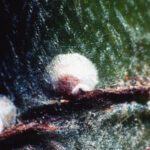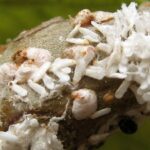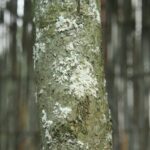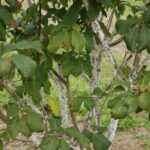Recently, white prunicola scales (Pseudaulacaspis prunicola) were detected on Prunus during a DNR nursery inspection. This is a significant scale pest of woody ornamentals and fruit trees in eastern states, but it is currently not established in Indiana. It is primarily a pest of cherry, lilac, and privet species. Its total reported host range spans 19 families and 28 genera, including common landscape species such as boxwood, holly, crabapple, and magnolia (ScaleNet). This would be a detrimental pest if it became widespread in Indiana, so it is worth familiarizing yourself with how to identify it.
Biology
White prunicola scale is an armored scale, which means the adults produce a flat, waxy outer coating or “shell”. Females remain immobile under their shells for the duration of their lifespan. At maturity, the winged males crawl out of their pupal case and find a female to mate with. Each female lays approximately 30-75 eggs (Hanks and Denno 1993). When eggs hatch, the nymphs are called “crawlers” because they are very mobile and will move around the plant to find a place to feed. This is the stage that is most vulnerable to pesticide control; it is also when the scales are most likely to spread to new host plants. They typically have between two or three generations in temperate climates.
Identification
Covers of mature females are slightly convex, round, approximately 1.5-2.5 mm in length, and white with a dark yellow to brown spot in the center (Fig. 1). Male covers are elongate, white, and have a yellow spot on one end (Fig. 2).
The closely related species, P. pentagona, or the white peach scale, has identical external morphology to the white prunicola scale. Where both of these species occur, they are frequently confused with one another. In general, P. pentagona is distributed in tropical and subtropical climates, while P. prunicola is common in temperate climates, although there is overlap in their range.
- Fig. 1. Adult female cover of P. prunicola. Photo: John. A. Davidson, Univ. Md, College Pk, Bugwood.org.
- Fig 2. Adult P. pentagona. Note the elongate males. Photo: Ján Kollár, ForestPests.eu.
- Fig 3. P. pentagona infestation. Photo: Milan Zúbrik, ForestPests.eu.
- Fig. 4. P. prunicola infestation on lilac. Photo: Brian Kunkel, University of Delaware.
Host damage
White prunicola scales colonize the branches of their host plants. Infestations resemble a white dusting or snow on the bark, or can even look like a powdery fungal infection (Figs. 3, 4). Infested plants suffer from stunting and leaf drop, and branch dieback or whole tree death can occur in severe cases.
Management
Armored scales are challenging to control due to their protective waxy shell, which protects them from pesticides. Targeting the crawler stage with chemical sprays achieves the best control, so monitoring for crawler emergence is essential to time these sprays correctly. However, many of these materials harm the beneficial insects that are important to keep scale populations in check. There are numerous natural enemies that attack scales, such as ladybeetles and parasitoid wasps, and killing them with conventional pesticides can worsen scale problems. Horticultural oils are recommended because they do not harm natural enemies. In addition, horticultural oils have some efficacy against adult armored scales.
For a more in-depth review of scale biology and management, see Purdue Entomology publication E-29: Scale Insects on Shade Trees and Shrubs by Cliff Sadof.
Report it!
As mentioned at the beginning, white prunicola scale is not known to be established in Indiana. If you believe you have found this scale, please submit a sample to the Purdue Plant & Pest Diagnostic Lab. You can also submit a report on Eddmaps.org or call 1-866-NO EXOTIC (1-866-663-9684).



